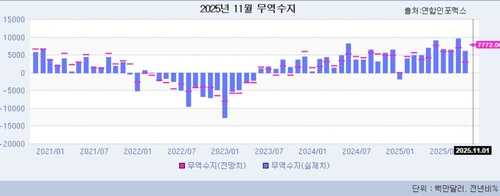
(Seoul=Yonhap Infomax) Seon Mi Jeong – South Korea’s exports in November are projected to extend their growth streak for a sixth consecutive month, driven by robust demand for semiconductors and automobiles despite one fewer working day compared to a year earlier.
According to a Yonhap Infomax survey of eight domestic and international financial institutions on November 26, exports for the month are forecast to increase 6.31% year-on-year to $59.839 billion.
In October, exports rose 3.6% from a year earlier to $59.57 billion.
Data from the Korea Customs Service showed that exports from November 1 to 20 climbed 8.2% year-on-year to $38.5 billion, with semiconductors and passenger vehicles each posting gains of over 20%. However, exports of petroleum products and auto parts declined.
By institution, NH Investment & Securities projected the highest export figure at $61.0 billion, while Meritz Securities forecast the lowest at $58.435 billion.
Imports in November are expected to rise 2.66% year-on-year to $52.067 billion. For the first 20 days of the month, imports totaled $36.1 billion, up 3.7% from a year earlier.
Experts attribute the export upturn to sustained strength in semiconductor shipments and a surge in automobile exports following the conclusion of tariff negotiations with the United States, which resulted in lower tariffs.
Lee Seung-hoon, a researcher at Meritz Securities, estimated that November exports based on customs clearance standards increased 3.8%, while imports likely fell 1.0%. On a daily average basis, exports and imports are estimated to have risen 8.4% and 3.4%, respectively.
“Semiconductors and shipbuilding are leading export growth, with automobiles joining the trend in November,” Lee said. “While auto exports may lose momentum, IT-related sectors led by semiconductors are expected to remain key growth drivers into next year.”
Choi Ji-wook, a researcher at Korea Investment & Securities, projected November exports and imports to rise 6.7% and 2.9%, respectively. “Semiconductor exports are likely to maintain double-digit growth at least through the end of next year, buoyed by the artificial intelligence (AI) cycle. Automobiles will benefit from lower tariffs due to US investment negotiations, but the recovery may be limited by weaker US auto demand in 2025,” Choi said.
Choi Yeon-woo noted, “Excluding shipbuilding, most major export items are expected to remain sluggish due to tariff effects and a slowdown in global growth.”
While exports of key products such as semiconductors and ships are expected to remain strong, other sectors may continue to underperform, resulting in a polarized export landscape.
Park Sang-hyun, a researcher at iM Securities, said, “Exports to China and the US, which had been weak, are expected to show a gradual recovery by region. The export momentum centered on semiconductors, automobiles, and shipbuilding is likely to persist for the time being.”
The trade surplus for November is projected at $7.772 billion, marking a tenth consecutive month in the black since a deficit in January.
smjeong@yna.co.kr
(End)
Copyright © Yonhap Infomax Unauthorized reproduction and redistribution prohibited.

